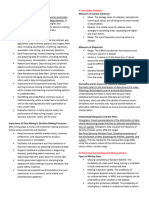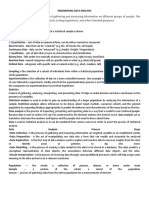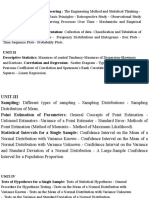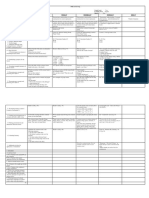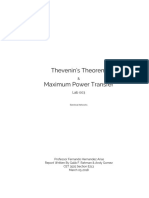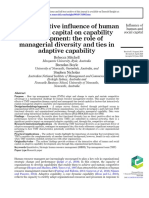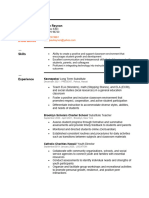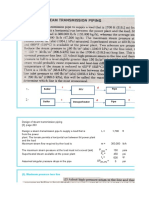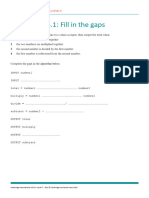## Engineering Data Analysis Reviewer
### 1. Introduction to Data Analysis
**a. Importance in Engineering:**
- Supports decision-making processes.
- Helps in identifying trends, patterns, and anomalies.
- Essential for quality control, reliability, and optimization.
**b. Types of Data:**
- **Qualitative Data:** Descriptive information.
- **Quantitative Data:** Numerical information, can be discrete or continuous.
### 2. Descriptive Statistics
**a. Measures of Central Tendency:**
- **Mean:** Average value.
- **Median:** Middle value in ordered data.
- **Mode:** Most frequently occurring value.
**b. Measures of Dispersion:**
- **Range:** Difference between maximum and minimum values.
- **Variance:** Measure of data spread around the mean.
- **Standard Deviation:** Square root of variance, indicates data spread.
**c. Data Visualization:**
- **Histograms:** Show frequency distribution.
- **Box Plots:** Display data spread and identify outliers.
- **Scatter Plots:** Show relationships between two variables.
### 3. Probability and Distributions
**a. Basic Probability Concepts:**
- **Probability:** Measure of the likelihood of an event.
- **Independent Events:** Events that do not influence each other.
- **Dependent Events:** Events that are influenced by one another.
**b. Probability Distributions:**
- **Discrete Distributions:** Binomial, Poisson.
- **Continuous Distributions:** Normal, exponential, uniform.
**c. Key Distributions in Engineering:**
- **Normal Distribution:** Symmetrical, bell-shaped curve.
- **Binomial Distribution:** For discrete binary outcomes.
- **Poisson Distribution:** For counting events over a fixed interval.
### 4. Inferential Statistics
**a. Sampling and Sampling Distributions:**
- **Population vs. Sample:** Entire group vs. subset of the population.
- **Sampling Distribution:** Distribution of sample statistics.
**b. Hypothesis Testing:**
- **Null Hypothesis (H0):** Assumes no effect or difference.
- **Alternative Hypothesis (H1):** Assumes an effect or difference.
- **P-Value:** Probability of observing test results under H0.
- **Significance Level (α):** Threshold for rejecting H0, commonly 0.05.
**c. Confidence Intervals:**
- **Interval Estimate:** Range within which a population parameter lies.
- **Confidence Level:** Probability that the interval estimate contains the parameter (e.g., 95%).
### 5. Regression Analysis
**a. Simple Linear Regression:**
- **Model:** \( Y = a + bX \)
- \( Y \): Dependent variable
- \( X \): Independent variable
- \( a \): Intercept
- \( b \): Slope
- **Least Squares Method:** Minimizes the sum of squared residuals.
**b. Multiple Regression:**
- **Model:** \( Y = a + b_1X_1 + b_2X_2 + ... + b_nX_n \)
- Accounts for multiple independent variables.
**c. Goodness of Fit:**
- **R² (Coefficient of Determination):** Proportion of variance explained by the model.
- **Adjusted R²:** Adjusted for the number of predictors in the model.
### 6. Analysis of Variance (ANOVA)
**a. Purpose:**
- Compares means across multiple groups to see if at least one is different.
**b. Types of ANOVA:**
- **One-Way ANOVA:** Compares means of three or more independent groups.
- **Two-Way ANOVA:** Examines the effect of two independent variables.
**c. Key Concepts:**
- **F-Statistic:** Ratio of variance between groups to variance within groups.
- **P-Value:** Used to determine the significance of results.
### 7. Non-Parametric Methods
**a. Characteristics:**
- Do not assume normal distribution.
- Used for ordinal data or non-normal distributions.
**b. Common Tests:**
- **Chi-Square Test:** Tests for independence or goodness of fit.
- **Mann-Whitney U Test:** Compares differences between two independent groups.
- **Kruskal-Wallis Test:** Non-parametric version of ANOVA.
### 8. Time Series Analysis
**a. Components:**
- **Trend:** Long-term movement in data.
- **Seasonality:** Regular pattern repeating at fixed intervals.
- **Cyclical:** Long-term cycles in data not tied to fixed intervals.
- **Random:** Irregular, unpredictable variations.
**b. Models:**
- **Moving Average:** Smoothing technique to identify trends.
- **Exponential Smoothing:** Weighted moving average method.
- **ARIMA (Auto-Regressive Integrated Moving Average):** Complex model for forecasting.
### 9. Quality Control and Reliability
**a. Control Charts:**
- **Purpose:** Monitor process variability and stability.
- **Types:** X-bar, R-chart, p-chart, c-chart.
**b. Process Capability:**
- **Cp and Cpk:** Measure process performance relative to specifications.
**c. Reliability Analysis:**
- **Failure Rate:** Frequency of failures over time.
- **Mean Time Between Failures (MTBF):** Average time between failures.
- **Weibull Analysis:** Reliability modeling and failure analysis.
---
This short reviewer covers the essential aspects of Engineering Data Analysis, providing a foundational
understanding of the key concepts, statistical methods, and practical applications involved in analyzing
engineering data.




































